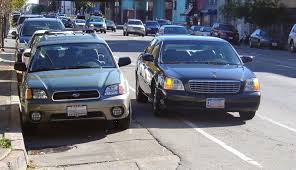Physical Address
304 North Cardinal St.
Dorchester Center, MA 02124
Physical Address
304 North Cardinal St.
Dorchester Center, MA 02124


This month, the Washington Area Bicyclist Association (WABA) published an analysis citing traffic ticket data to illustrate the following point:
Of the 723,237 parking tickets issued in this 5 month period, only 2,420 were for parking in bike lanes. That’s about 3 out of every 1,000 tickets. That comes to about 16 tickets per day, spread over more than 70 miles of bike lanes, or one ticket per day for every 4.5 miles of bike lane.
This extreme lack of parking enforcement jives with my biking experience, during which I routinely have to dangerously swerve, often abruptly, out of the bike lane into car lane traffic due to a car or truck in the bike lane.
I wanted to answer, though: What percentage of bike lane parking violators do DC police actually ticket? Let’s use my anecdotal experience to make some simple back-of-the-envelope calculations.
There are 70 miles of DC bike lanes that function 24 hours a day. This comes out to a total of (70 miles) * (24 hours) * (60 minutes / hour) = 100,800 bike lane mile-minutes per day.
Here are two measures based on anecdotal evidence:
Note: The observed area measure is extremely generous, as it assumes that at every moment in my trip, I observe the entire 1-mile stretch of my route. This is obviously false, meaning I actually observe a far smaller percentage of total bike lane mile-minutes each day. Some of this overestimation, however, is cancelled out by my assumption in the violations measure that bike lane violations are instantaneous events rather than the reality that they persist anywhere from 30 seconds to 30 minutes at a time. For the purpose of this simple thought exercise, we will assume these two measurement issues largely cancel each other out, though it seems reasonable to assume the first issue is a far greater overestimation of observation than the latter is an overestimate of violations, meaning I am underestimating the number of violations.
If one extrapolates my anecdotal experience (almost surely improper to some extent: I bike mostly during commuting hours and in highly-trafficked areas, but for the sake of this simple thought exercise, let us assume my commute is representative of all bike lanes at all times), then it can be calculated there are approximately: (10 violations I see daily) / (0.01885% of bike lane mile-minutes I experience) = 53,053 parking violations each day.
There are 16 tickets issued each day for bike lane parking violations. This means that only 16 / 53,053 = 0.0302% of all daily violators are ticketed.
The fine for parking in a bike lane is currently $65 for any type of vehicle (though proposed to increase to $200 for private cars and $300 for commercial vehicles). The extreme unlikelihood for getting ticketed, though, means that a driver must only place a value of ($65 fine) * (0.0302% ticket rate) = $0.00196 for obstructing the bike lane to make parking there worthwhile.
Thus, if parking in the bike lane gives a driver greater than two-tenths of a penny of utility, then it’s a cost-effective decision for him or her, as they externalize the vast majority of their true parking costs onto cyclists by putting their lives at risk. Those are the perverse incentives DC’s parking enforcement rate and fine system have set up.
Great analysis, thanks.
There’s no systematic way to count the frequency of bike lane blocking violations, but when I ride crosstown I mentally track “unobstructed blocks” both for bike lanes and double-parked regular lanes. From that I observe that during daytime there are very few free-flowing blocks. The legal language instructing cyclists to ride “as far to the right as practicable” then requires cyclists to either weave in and out of traffic or use the 2nd lane from the right for block after block.
One thing though: I’m pretty sure the proposal to increase fines for blocking bike lanes was dropped when that bill was combined with another that addressed Vision Zero regulatory requirements, so we’re stuck with the low price for a while.
Back in 2010 there was another proposal to raise these fines, but it was shot down by then Council Chair Vincent Gray. Since then DC has added almost 40 miles of on-road bikeways and almost 15 miles of separated bikeway, but the rate of violation and the entitlement drivers express when asked to move has not abated in the slightest. We keep doing the same minimal things and somehow we expect different outcomes…
Just think of bike lanes as “mixed-use” spaces. /s
Theft is generally cost-effective for the thieves.